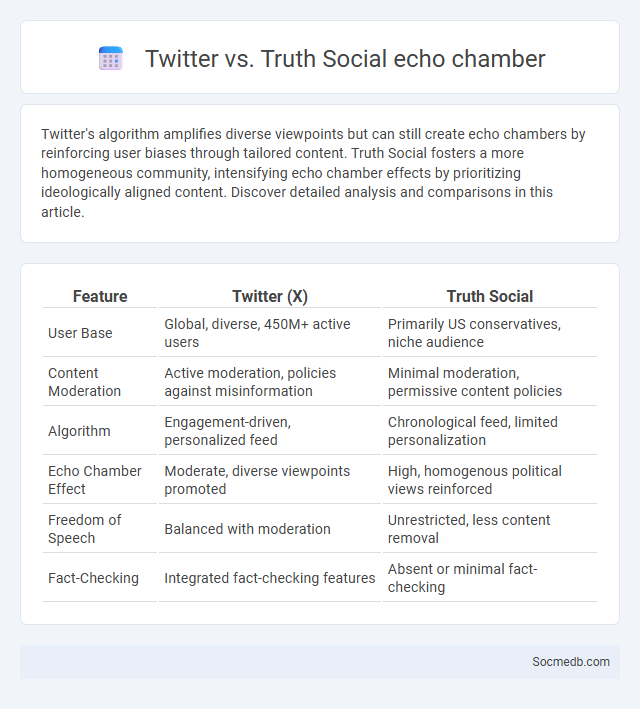
Photo illustration: Twitter vs Truth Social echo chamber
Twitter's algorithm amplifies diverse viewpoints but can still create echo chambers by reinforcing user biases through tailored content. Truth Social fosters a more homogeneous community, intensifying echo chamber effects by prioritizing ideologically aligned content. Discover detailed analysis and comparisons in this article.
Table of Comparison
| Feature | Twitter (X) | Truth Social |
|---|---|---|
| User Base | Global, diverse, 450M+ active users | Primarily US conservatives, niche audience |
| Content Moderation | Active moderation, policies against misinformation | Minimal moderation, permissive content policies |
| Algorithm | Engagement-driven, personalized feed | Chronological feed, limited personalization |
| Echo Chamber Effect | Moderate, diverse viewpoints promoted | High, homogenous political views reinforced |
| Freedom of Speech | Balanced with moderation | Unrestricted, less content removal |
| Fact-Checking | Integrated fact-checking features | Absent or minimal fact-checking |
Understanding Echo Chambers in Social Media
Echo chambers in social media occur when algorithms curate content that reinforces Your existing beliefs, limiting exposure to diverse perspectives. This phenomenon increases polarization by promoting homogeneous viewpoints and diminishing critical thinking. Understanding the mechanics of echo chambers helps You recognize biases and encourages actively seeking varied information sources.
Twitter’s Algorithm and the Formation of Echo Chambers
Twitter's algorithm prioritizes content based on user engagement, promoting tweets that align with your interests and interactions, which can intensify confirmation bias. This selective exposure fosters the formation of echo chambers where diverse viewpoints are minimized, reinforcing existing beliefs and limiting critical discourse. Understanding Twitter's algorithm dynamics is crucial for users aiming to encounter a balanced and comprehensive range of perspectives.
Truth Social: A Different Echo Chamber?
Truth Social offers a distinct social media platform designed to foster free speech, positioning itself as an alternative echo chamber to mainstream networks like Twitter and Facebook. Its user base largely consists of conservative voices, creating a community that emphasizes content reflecting specific political ideologies. This ideological clustering impacts information dissemination, reinforcing beliefs through selective exposure and curated interactions within the platform.
Comparing User Demographics: Twitter vs Truth Social
Twitter attracts a diverse user base with approximately 38% of U.S. adults aged 18-29 actively engaging on the platform, while Truth Social primarily appeals to older demographics, with a significant portion of users aged 45 and above. Twitter's global reach includes over 450 million monthly active users, emphasizing urban and younger populations, whereas Truth Social caters predominantly to politically conservative audiences seeking alternatives to mainstream social media. User engagement metrics reveal Twitter's broader demographic diversity contrasts with Truth Social's concentrated ideological community focus.
Content Moderation and Its Impact on Dialogue
Content moderation on social media platforms plays a critical role in shaping online dialogue by filtering harmful, misleading, or inappropriate content while preserving freedom of expression. Effective moderation strategies enhance constructive conversations and reduce the spread of misinformation, cyberbullying, and hate speech, fostering safer and more inclusive digital environments. Balancing automation technologies and human oversight remains essential to address complex contextual nuances and maintain transparent moderation policies.
Political Polarization on Both Platforms
Social media platforms like Facebook and Twitter significantly contribute to political polarization by creating echo chambers where users are primarily exposed to content that reinforces their existing beliefs. Algorithms prioritize engagement, often promoting extreme viewpoints and misinformation, which intensifies divisions and reduces exposure to diverse perspectives. Understanding how these platforms influence your information consumption can help mitigate bias and promote more balanced political discourse.
The Role of Influencers and Virality in Echo Chambers
Influencers play a pivotal role in shaping opinions within social media echo chambers by amplifying specific narratives and reinforcing group biases. Their content often goes viral, rapidly spreading ideas that resonate with their followers, which intensifies the homogeneity of information consumed. Understanding how your engagement contributes to these cycles helps you navigate and diversify your social media experience.
Strategies Users Employ to Escape Echo Chambers
Users employ diverse strategies to escape social media echo chambers, such as actively seeking out contrasting viewpoints by following accounts with different opinions and engaging in cross-ideological discussions. You can also diversify your news sources and use algorithms that prioritize exposure to varied content, reducing the risk of confirmation bias. Leveraging tools like content filters and platform settings helps broaden your information landscape and promotes a more balanced online experience.
Implications for Free Speech and Public Discourse
Social media platforms have transformed public discourse by enabling widespread, instantaneous communication while raising complex challenges for free speech. Content moderation policies and algorithm-driven visibility often influence which viewpoints gain prominence, potentially limiting diverse perspectives and fostering echo chambers. The regulation of misinformation and harmful content on these platforms remains a critical issue affecting democratic debate and the balance between open expression and community safety.
Future Trends: Will Echo Chambers Deepen or Dissolve?
Emerging social media algorithms will increasingly personalize content, potentially deepening echo chambers by reinforcing users' existing beliefs and limiting exposure to diverse perspectives. However, advancements in AI-driven content moderation and platform strategies aimed at promoting cross-ideological dialogue could help dissolve these bubbles. Your engagement with varied sources and critical evaluation plays a crucial role in navigating and counteracting the intensification of online echo chambers.
 socmedb.com
socmedb.com